Announcement: My online Land Navigation course includes four hours of video instruction, and two downloadable PDF books, all for about the same price as a typical paperback book. Get my Land Navigation course here.
How to Use a
Lensatic Compass
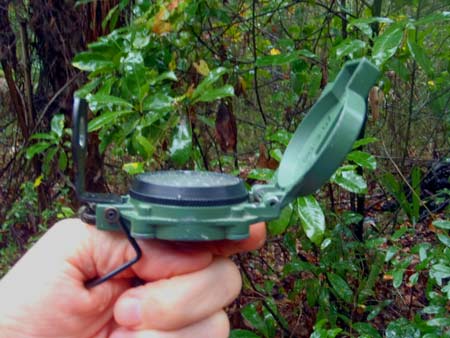
The lensatic compass is used by the U.S. Military. It has its advantages and disadvantages over the orienteering compass.
One advantage is it's probably more accurate when it comes to "shooting azimuths," meaning the act of determining the specific compass direction to a spot on the earth.
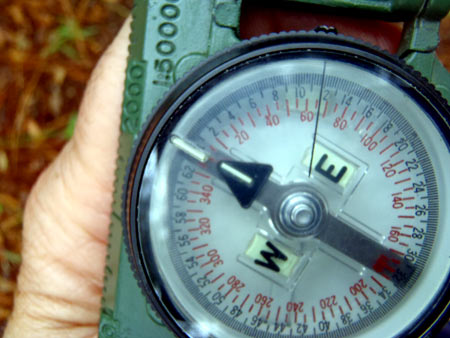
Learn Land Navigation Now. Enroll in my personalized step-by-step video-based online course. We'll start from the beginning, and go through everything you need to know to find your way over the terrain. With solid land-navigation skills, you'll be more confident and "at home" in the wilderness. Plus, as a web site visitor, you get a 50% discount off the regular price, meaning you get the whole course for $10. ENROLL NOW.
One disadvantage is, unlike the orienteering compass, it's not easy to make it double as a protractor, meaning you'll have to carry a protractor with you.
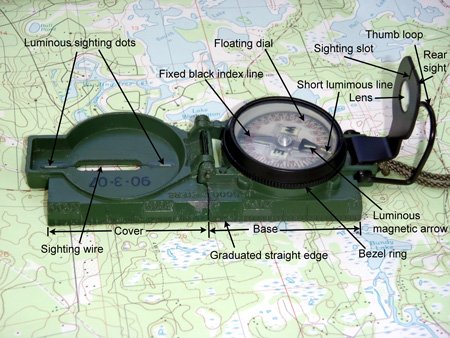
Lensatic Compass Parts
Use the illustration above to familiarize yourself with the components of a lensatic compass. Some of the components' terms are used in the explanations below.
Point of Interest
An "azimuth" is pretty much the same as a "bearing." There is some technical difference between the two, but for all practical civilian purposes, the words are interchangeable.
How to Hold a Lensatic Compass
It's important to hold your compass stable, squarely in front of you, and level. Holding any compass in a slack and half-a**ed (that's an old military term) manner can cause you to go off in the wrong direction.
Two-Hand Hold
To make a two-hand hold:
1. Open the cover completely and pull back the rear sight.
2. With the thumb loop all the way down under the compass, put the thumb of one hand all the way inside the loop, and place the index finger of that same hand along one side of the compass.
3. Make an "L" shape with the index finger and thumb of your other hand. Put that hand up to the compass, steadying the compass by placing your index finger along the compass's side, and wrapping your thumb between the bezel ring and the rear sight.
4. Now, hold the compass level and squarely in front of you. Imagine that you want to hold it as if it were firmly mounted in that position. You don't want to hold it crooked, cockeyed, or off level. Hold it square and straight in front of you like you mean business.
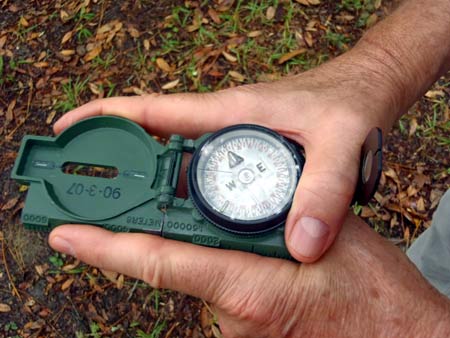
Two-hand Hold of the Lensatic Compass
How to Find a Map Direction
To find directions from your map, you're going to need a protractor, a special instrument used for measuring angles.
Looking at the photo below, let's say you're at the north end of Sheeler Lake, where the penciled X is. You want to go cross country directly to Devil's Wash Basin, a deep and beautiful lake you've heard a lot about.
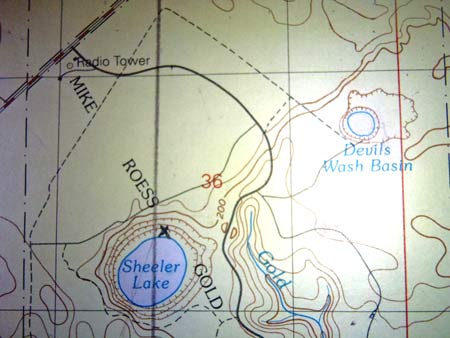
Using your protractor or other straight edge, you draw a line from your current position in the direction of where you want to go.
Then, you place your protractor on the map with its center point at your current position, making sure the north-south lines on the protractor line up with the north-south lines on the map.
You then see where the line you drew intersects with the protractor's numbers, in this case 062 degrees.
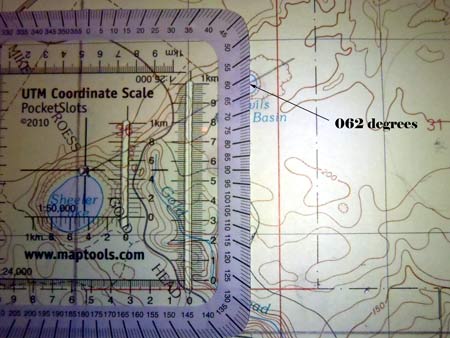
If the magnetic declination in your area were zero, you'd proceed in the direction of 062 degrees. In your case, however, your declination is 004 degrees West, meaning you'll have to add 004 degrees before you set your compass. (Be sure you understand magnetic declination. If you don't, visit the page just hyperlinked.)
Set Your Compass for Your Intended Azimuth
1. Hold your compass in the two-hand hold, steady and level in front of you.
2. Turn your entire body as a unit until 066 (062 + 004) degrees falls under your compass's fixed black index line.
3. Making sure you don't move to change directions, turn the glass compass housing until the short luminous line is directly lined up with the luminous magnetic arrow. The bezel clicks as it moves--three degrees for every click. You can use this feature to set your compass in the dark.
4. Your compass is now set. Whenever the luminous magnetic arrow lines up with the luminous short line, you're following your intended azimuth. Well, that is, unless you're doing something silly like holding the compass backwards. Hey, it happens! But not to you, I trust.

In the daytime, you'll normally find something in the distance on your azimuth and walk to it, so you don't have to keep staring at the compass.
At night, however, or in other periods of limited visibility (fog, blizzard, etc) keeping these two luminous bits lined up will be your only remedy. The fact that they glow in the dark (especially, if they're the tritium kind which will glow for years without having to be exposed to light) means you can use your compass without a light for night navigation.
Point of Interest
In addition to 360 degrees to measure directions in a circle, the military also uses 6,400 mils. The degrees are in red, and are the ring's inner measurements. The mils are in black, and are the outer measurements on the ring. I guess the military needs the extra accuracy now and then say, for example, to precisely place artillery fire. Close is good enough in horsehoes, but I'm hoping exact is the standard for artillery fire.
How to Determine the Bearing of a Distant Object
For this task, the lensatic compass really shines. Let's say you see a water tower off in the distance. You want to find your position using the technique of partial resection, so you need to know that tower's bearing with a high degree of accuracy.
To find the tower's bearing with your lensatic compass:
1. Turn the compass cover more or less perpendicular to the base.
2. Hold the compass with your thumb fully in the thumb ring, and your index finger wrapped around and gripping the circular part of the underneath of the compass's base. Steady the compass by allowing the hand holding the compass to rest in the cupped palm of your other hand. As long as you can hold the compass level and steady, the exact grip doesn't matter.
3. Holding the compass up to your face, angle the rear sight so that you can read the compass dial clearly through the lens while peering through the sighting slot and lining your distant target (the water tower, in this case) up with the sighting wire. Now, read the degree marking under the fixed black index line. You now have your target's bearing.

Determining a Bearing, or "Shooting an Azimuth"
Using Your Compass Sights to "Shoot an Azimuth"
To use your lensatic compass to find the direction of your intended azimuth (which you probably got from your map, using your protractor):
1. Hold the compass steady and level, and up to your face.
2. Turn your entire body as a unit until your predetermined azimuth falls under the fixed black index line.
3. Look through the sighting slot and find some target (a tree, boulder, whatever) that lines up with your sighting wire.
4. Proceed to that target.
5. Keep doing this until you get to where you want to go.

